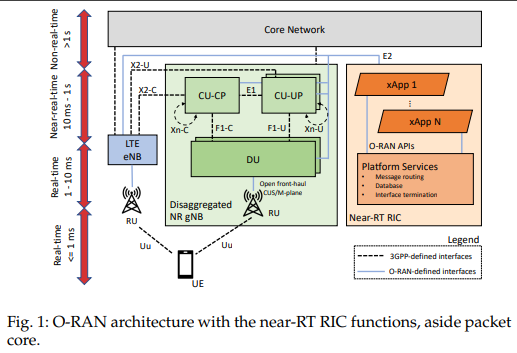Based on ns3-mmwave
Pre-reading
Nowadays, classic RANs are deployed with monolithic network functions (e.g., base stations) on black-box hardware. Such architecture is considered static and hard to reconfigure on-demand without any manual on-site intervention.
The O-RAN architecture disrupts the classical approach by adopting the principles:
- Disaggregation
- Openness
- Virtualization
- Programmability.
In O-RAN, the classic base station is disaggregated, i.e divided across multiple RAN nodes. The interfaces between the different nodes are open and standardized, to achieve multi-vendor interoperability. Network functions that implement the classic RAN operations are virtualized and software-based and deployed on white box hardware. Software enables algorithmic and programmatic control based on the current network status, enabling the dynamic configuration of the infrastructure.
The contributions of this paper are as follows. System Design: We design and build a standard-compliant near-RT RIC platform with O-RAN-defined open interfaces and service models. Integration: We build ns-O-RAN, a virtualized and simulated environment for O-RAN, which bridges large scale 5G simulations in the open-source ns-3 with a real-world nearRT RIC. TS Optimization: We build a data-driven AI-powered TS xApp in the near-RT RIC to maximize the UE throughput utility through handover control. Performance Evaluation: We extensively evaluate the xApp using different Key Performance Indicators (KPIs), such as UE throughput, spectral efficiency, and mobility overhead on a large-scale of RAN network created by ns-O-RAN.
O-RAN Cellular Architecture

- RAN Protocol Stack: The baseband unit of the NR base station, also called the Next Generation Node Base (gNB), is logically split into RAN functional nodes - Centralized Unit - Control Plane (CU-CP), Centralized Unit - User Plane (CU-UP), Distributed Unit (DU), and Radio Units (RUs).
- RAN Intelligent Controllers: The near-RT RIC is typically deployed as a network function in a virtualized cloud platform at the edge of the RAN.
- E2 interface: E2 is a bi-directional interface that splits the Radio Resource Management(RRM) between the E2 nodes and the near-RT RIC. The procedures and messages exchanged over the E2 interface are standardized by E2 Application Protocol (E2AP). Using E2AP, the E2 nodes can send reports to the near-RT RIC with RAN data or UE context information. In addition, the near-RT RIC can send control actions containing RRM decisions and policies to the E2 node.
Intelligence in the RIC
the O-RAN alliance has defined specifications for life cycle management of ML driven RAN control. In fact, in O-RAN any ML model shall be trained offline and deployed as xApps for online inference and RRM control in the RIC.
NS3
one of the major reason of using ns-3 in this work is because of the very accurate 3GPP stochastic models.
available within the simulator combined with the possibility of simulate large scale deployments with no telecommunication hardware required. These peculiarities are also enhanced by the possibility of integrate real world features, such as buildings and obstacles and mobility models for the wireless nodes, to create realistic scenarios. In this work, we use the 5G and mmWave ns-3 module [12], which extends the ns-3 LTE module with new detailed modeling of the mmWave channel that can capture spatial clusters, path dynamics, antenna patterns and beamforming algorithms.
System Model


Reference List
- A. Lacava, M. Polese, R. Sivaraj, R. Soundrarajan, B. S. Bhati, T. Singh, T. Zugno, F. Cuomo, T. Melodia, “Programmable and Customized Intelligence for Traffic Steering in 5G Networks Using Open RAN Architectures,” arXiv:2209.14171 [cs.NI], October 2022.
- https://openrangym.com/ran-frameworks/ns-o-ran
- https://openrangym.com/tutorials/ns-o-ran
- https://github.com/wineslab/colosseum-near-rt-ric